|
Estornino Pinto European Starling Sturnus vulgaris
|
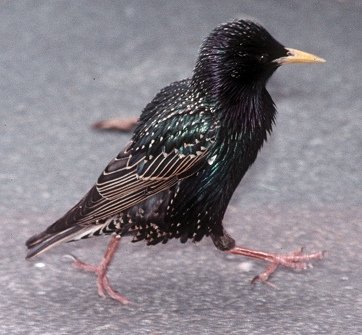 |
|
Foto: M. Oberle
|
|
Estornino Pinto European Starling Sturnus vulgaris
|
 |
|
Foto: M. Oberle
|
|
Ave de plumaje negro lustroso con el pico afilado y amarillo. Tamaño: 22 cm.; peso: 77-83 g. En plumaje invernal recién estrenado tiene contrastantes pecas blancas o color ante y el pico es oscuro. Audio (M. Oberle). A diferencia de los seres humanos, muchas especies de aves pueden detectar la luz ultravioleta y, en esa luz, existe una diferencia entre los machos y las hembras del Estornino Pinto. El Estornino Pinto, consecuentemente, no tiene ningún problema al distinguir los dos sexos de su propia especie. Esta ave europea ha sido introducida a América del Norte y Jamaica, donde se apodera de las cavidades que algunas especies nativas usan para nidificar. Con frecuencia tiene dos puestas por año de 4 a 6 huevos cada una. Potencialmente representa una amenaza para la Mariquita y otras especies nativas que anidan en cavidades. Se ha visto en Luquillo (el 21 de diciembre de 2003), en Boquerón y Cabo Rojo---cerca de los territorios de cría de la Mariquita---y también la especie ha sido reportada en las islas Vírgenes. La amenaza que representa para las especies nativas continúa. Si ve un Estornino Pinto, por favor repórtelo al Departamento de Recursos Naturales y Ambientales. TAXONOMÍA: PASSERIFORMES; STURNIDAE. |
|
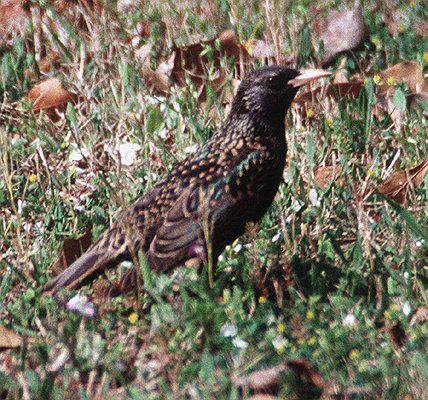 |
|
|
Foto: G. Beaton
|
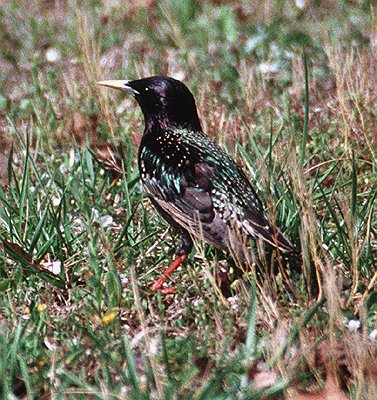 |
|
|
Foto: G. Beaton
|
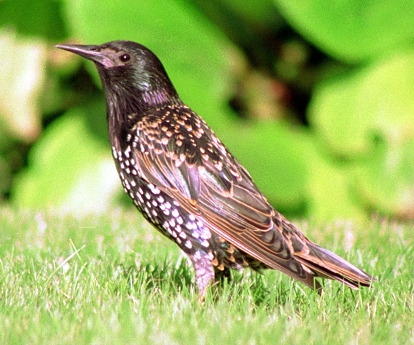 |
|
Plumaje no reproductivo - Foto: J. Wilson
|
 |
|
|
Plumaje no reproductivo -
Foto: M. Oberle |
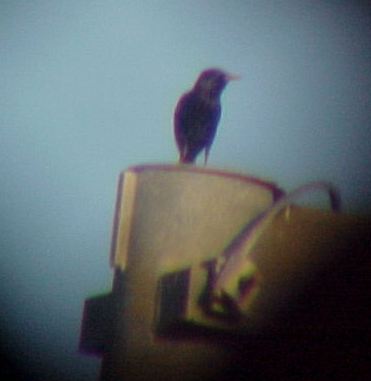 |
|
Luquillo, el 21 de diciembre de 2003 -
Foto: J. Salguero |
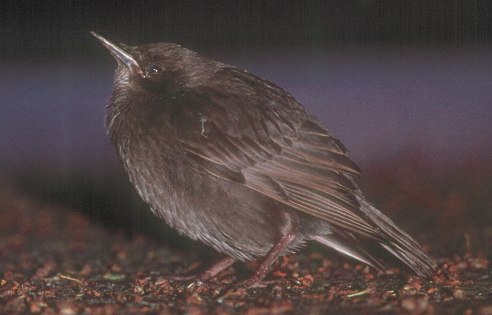 |
|
Juvenil - Foto: M. Oberle
|
|
Referencias Bent, A.C. 1950. Life histories of North American wagtails, shrikes, vireos, and their allies. Smithsonian Instit. U.S. National Museum Bull. 197. (Reprinted by Dover Press, NY, 1965). Cabe, P. R. 1993. European Starling (Sturnus vulgaris). No. 48 in The birds of North America (A. Poole and F. Gill, eds.). Acad. Nat. Sci., Philadelphia, PA, and Am. Ornithol. Union, Washington, D.C. Cabe, P. R. 1999. Dispersal and population structure in the European Starling. Condor 101:451-454. Camacho Rodríguez, M., J. Chabert Llompart, and M. López Flores. 1999. Guía para la identificación de las aves exóticas establecidas en Puerto Rico. Depto. de Recursos Naturales y Ambientales, San Juan, PR. Ehrlich, P.R., D.S. Dobkin, and D. Wheye. 1988. The birder’s handbook: a field guide to the natural history of North American birds. Simon and Schuster/ Fireside, NY. Feare, C. and A. Craig. 1999. Starlings and Mynas. Princeton. Martin, T. E., A. P. Moller, S. Merino, and J. Clobert. 2001. Does clutch size evolve in response to parasites and immunocompetence? Proc. Natl. Acad. Sci. U. S. A. 98:2071-2076. Pinxten, R., M.Eens, and R.F. Verheyen. 1994. Communal breeding in the European Starling: Evidence from DNA fingerprinting. Auk 111:482-486. Raffaele, H.A. 1989. A guide to the birds of Puerto Rico and the Virgin Islands. Princeton. Raffaele, H.A. 1989. Una guía a las aves de Puerto Rico y las Islas Vírgenes. Publishing Resources, Inc., Santurce, PR. Raffaele, H.A., J.W. Wiley, O.H. Garrido, A.R. Keith, and J.I. Raffaele. 1998. Guide to the birds of the West Indies. Princeton. Swaddle, J. P. and A.A. Biewener. 2000. Exercise and reduced muscle mass in starlings. Nature 406:585. http://www.utahbirds.org/BirdStory.htm Estornino Pinto, versión en inglés Próxima especie en el orden taxonómico Especie anterior en el orden taxonómico |
|